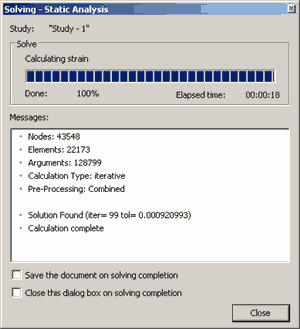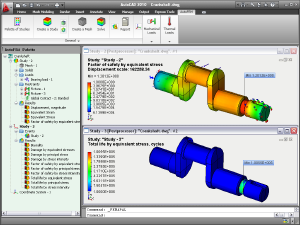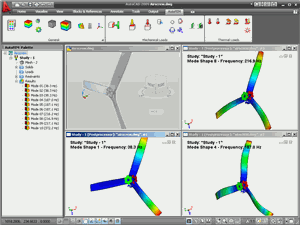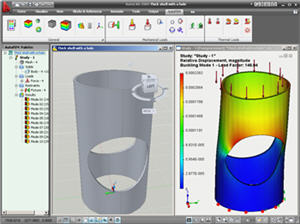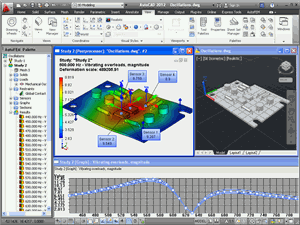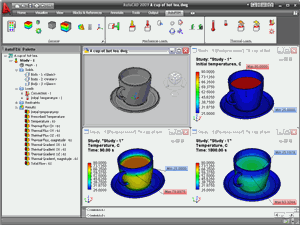Comparative Benchmarks
To illustrate the AutoFEM Analysis performance, we show several comparative benchmarks comparing the solving time and peak memory consumption of AutoFEM, Ansys and SolidWorks Simulation.
Parameters of the computer system:
Processor - Intel(R) Core(TM)2 Duo CPU E8400 @ 3.00GHz
Random Memory - 8 Gb, DDR2 333 MHz
The best result in the tables is marked with green colour.
Linear Static Analysis
AutoFEM Analysis
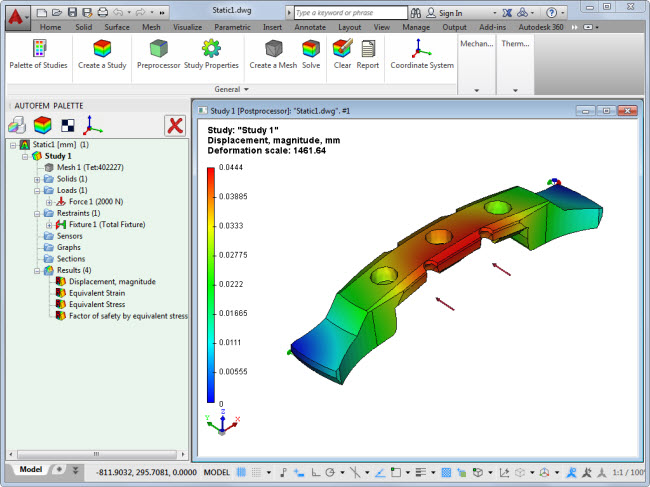
Ansys WorkBench
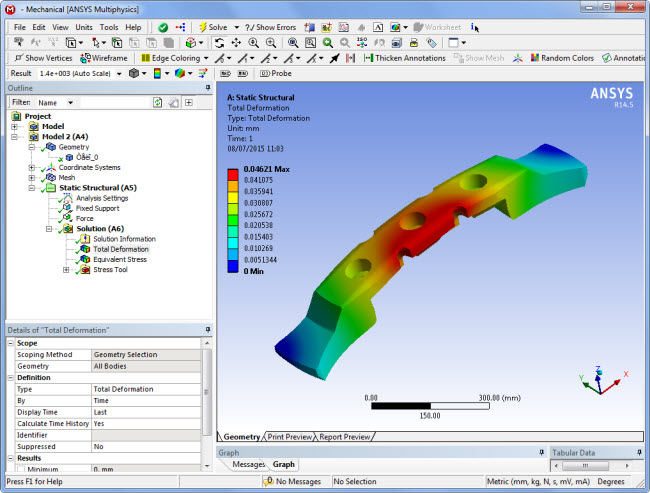
SolidWorks Simulation
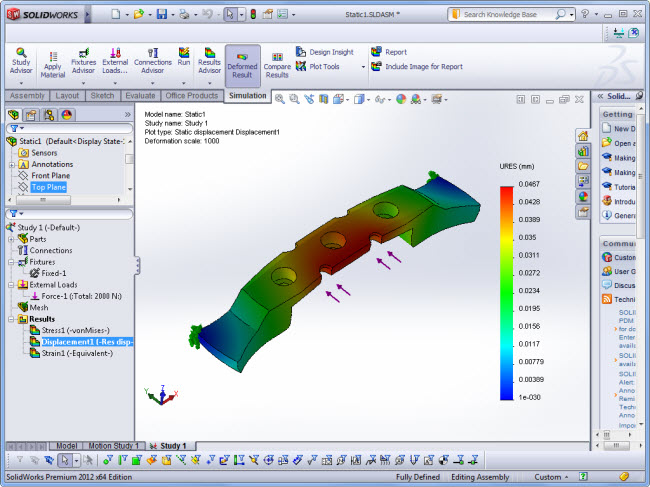
Linear Static Analysis, iterative solving method
| CAE System |
Number of elements |
Number of equations |
Solving time, s |
Peak Memory Usage, MB |
| AutoFEM Analysis | 402,227 | 1,689,282 | 81 | 2,070 |
| Ansys WorkBench | 399,329 | 1,648,450 | 169 | 1,600 |
| SolidWorks Simulation | 406,836 | 1,749,819 | 79 | 950 |
Linear Static Analysis, direct solving method
| CAE System |
Number of elements |
Number of equations |
Solving time, s |
Peak Memory Usage, MB |
| AutoFEM Analysis | 44,621 | 209,499 | 17 | 1,211 |
| Ansys WorkBench | 44,627 | 233,421 | 33 | 1,620 |
| SolidWorks Simulation | 44,487 | 204,150 | 46 | 1,220 |
Frequency Analysis
AutoFEM Analysis
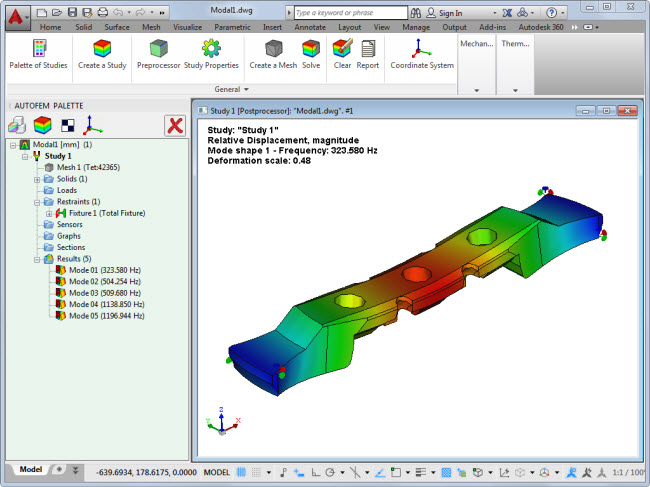
Ansys WorkBench
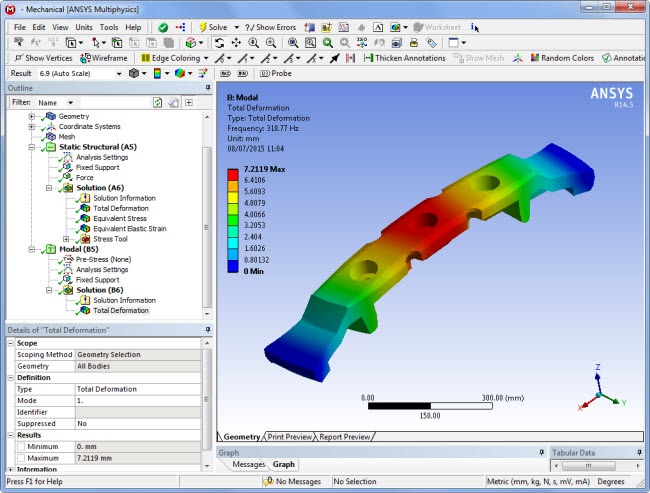
SolidWorks Simulation

Frequency Analysis, iterative solving method, 5 modes
| CAE System |
Number of elements |
Number of equations |
Solving time, s |
Peak Memory Usage, MB |
| AutoFEM Analysis | 42,983 | 199,314 | 39 | 430 |
| Ansys WorkBench | 41,410 | 216,573 | 57 | 1,773 |
| SolidWorks Simulation | 42,679 |
195,750 |
58 | 116 |
Frequency Analysis, direct solving method, 5 modes
| CAE System |
Number of elements |
Number of equations |
Solving time, s |
Peak Memory Usage, MB |
| AutoFEM Analysis | 44,621 | 209,499 | 43 | 1,210 |
| Ansys WorkBench | 44,627 | 233,421 | 39 | 1,772 |
| SolidWorks Simulation | 44,487 | 204,150 | 46 | 1,009 |
Buckling Analysis
AutoFEM Analysis

Ansys WorkBench
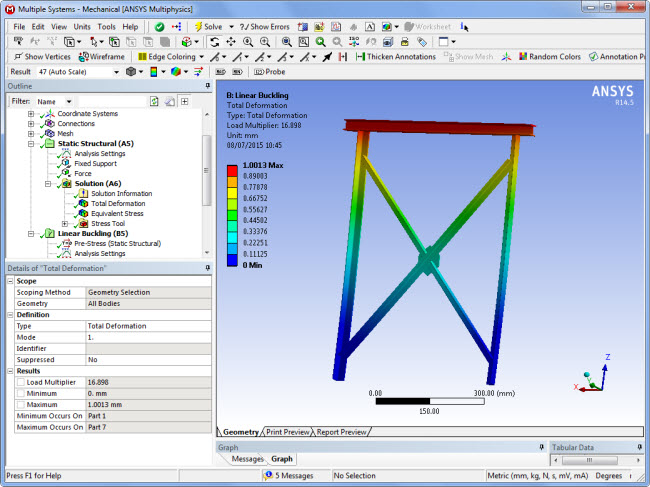
SolidWorks Simulation
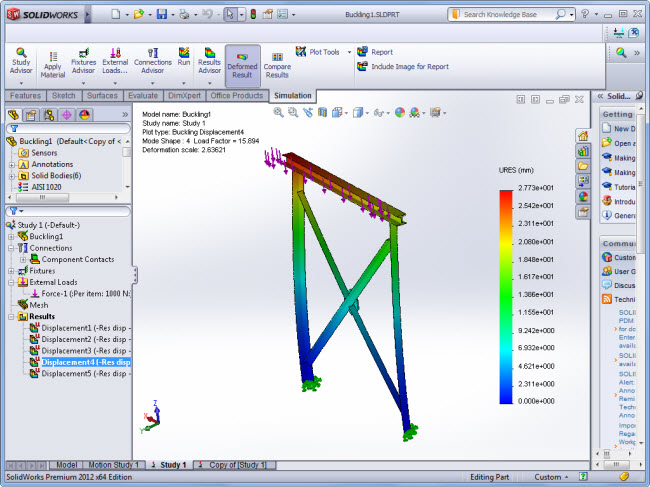
Buckling Analysis, iterative solving method, 5 modes
| CAE System |
Number of elements |
Number of equations |
Solving time, s |
Peak Memory Usage, MB |
| AutoFEM Analysis | 170,267 | 1,005,393 | 207 | 2,018 |
| Ansys WorkBench | 171,521 | 978,597 | n/a | out of memory |
| SolidWorks Simulation | 172,744 |
948,666 |
250 | 3,192 |
Buckling Analysis, direct solving method, 5 modes
| CAE System |
Number of elements |
Number of equations |
Solving time, s |
Peak Memory Usage, MB |
| AutoFEM Analysis | 33,994 | 204,414 | 26 | 811 |
| Ansys WorkBench | 33,808 | 205,500 | 57 | 1,920 |
| SolidWorks Simulation | 33,565 | 209,838 | 42 | 1,009 |
Conclusion.
AutoFEM Analysis provides the calculation performance of the same level as other famous CAE systems.
AutoFEM and other CAE systems comparison
( AutoFEM vs Ansys & SolidWorks Simulation )
We are often asked, "Does AutoFEM provide an acceptable precision of calculations? Is there any comparison AutoFEM and other famous finite element software systems?"
Below you can find a comparison of our tutorial examples, solved, besides AutoFEM, in two other well known finite element systems: ANSYS Workbench and SolidWorks Simulation (CosmosWorks).
Linear Static Strength Analysis
The result "Displacements" in AutoFEM Analysis:

The result "Displacements" in SolidWorks Simulation:

The result "Displacements" in Ansys Workbench:
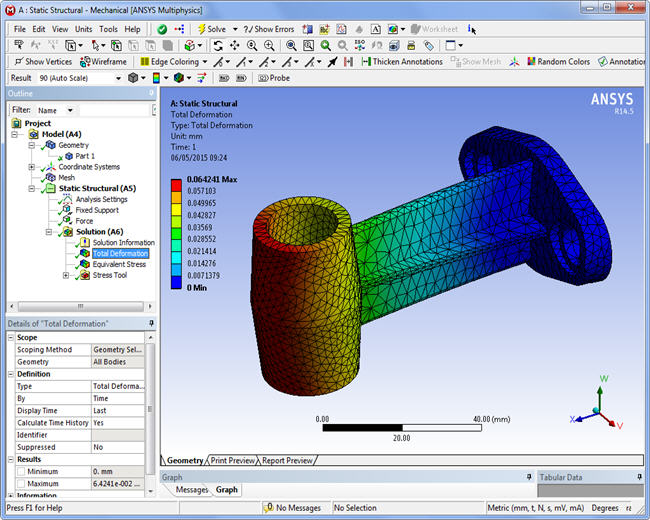
Comparison:
|
Ansys |
CosmosWorks | ||
| Max Displacements, mm | 0,06497 | 0.06424 | 0.06406 | |
| Number of tetrahedra | 9,924 | 10,797 | 10,601 |
Conclusion:
We can see, the maximal displacements are very close in spite of the difference between finite element meshes.
The result "Stresses von Mises" in AutoFEM Analysis:
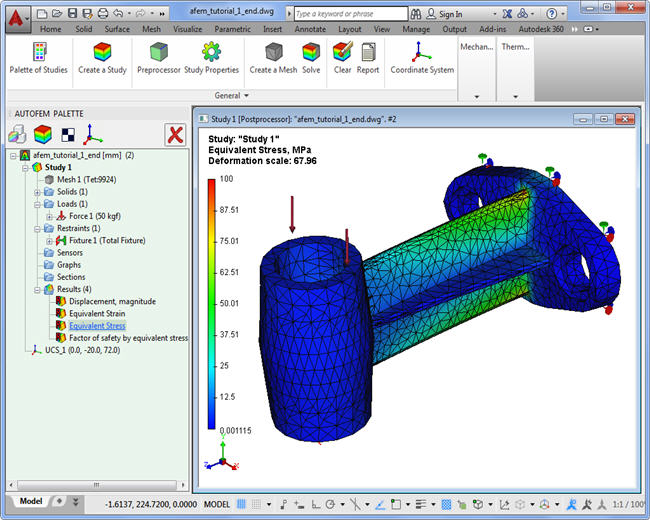
The result "Stresses von Mises" in SolidWorks Simulation:
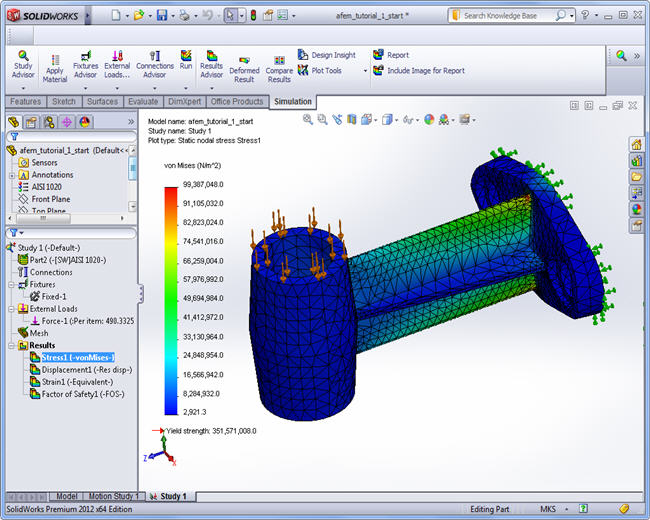
The result "Stresses von Mises" in Ansys Workbench:
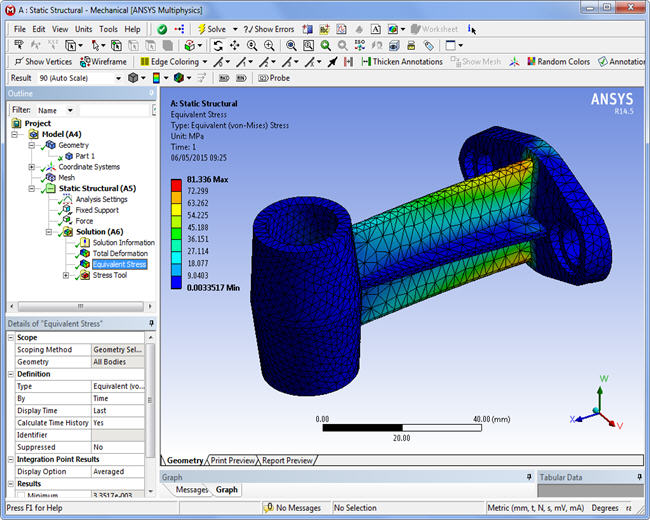
Comparison:
|
Ansys |
CosmosWorks | ||
| Max Stresses, MPa | 67,96 | 81,336 | 99,387 |
|
| Number of tetrahedra | 1,281 | 840 | 1,105 |
Conclusion:
We can see fairly large disturbance in stress estimations between all FEA systems because of the finite element mesh coarseness.
Frequency Analysis (determining resonance frequencies)
First mode, AutoFEM Analysis:
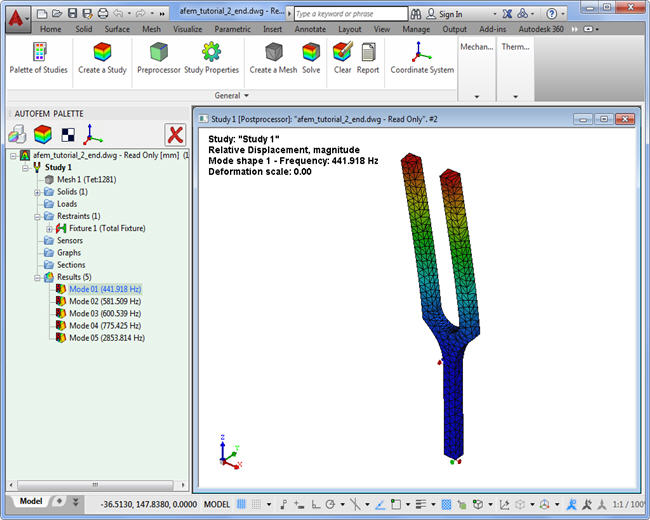
First mode, Ansys WorkBench:
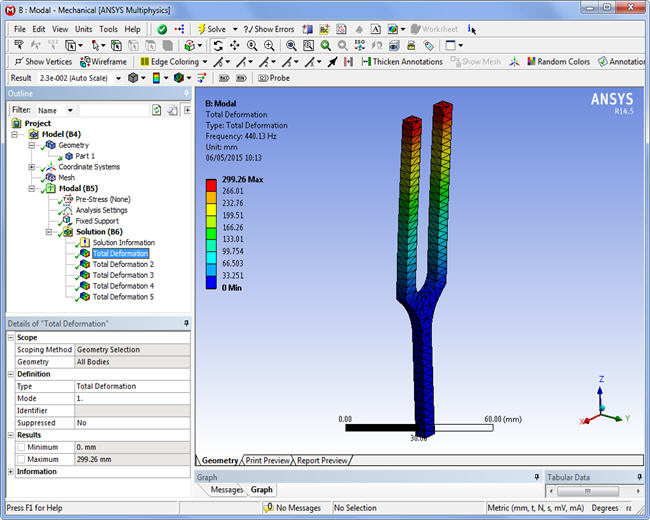
First mode, SolidWorks Simulation:
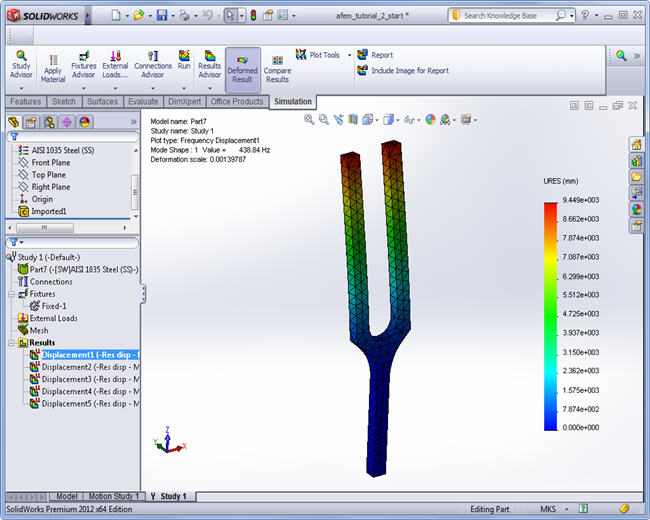
Fifth mode, AutoFEM Analysis:
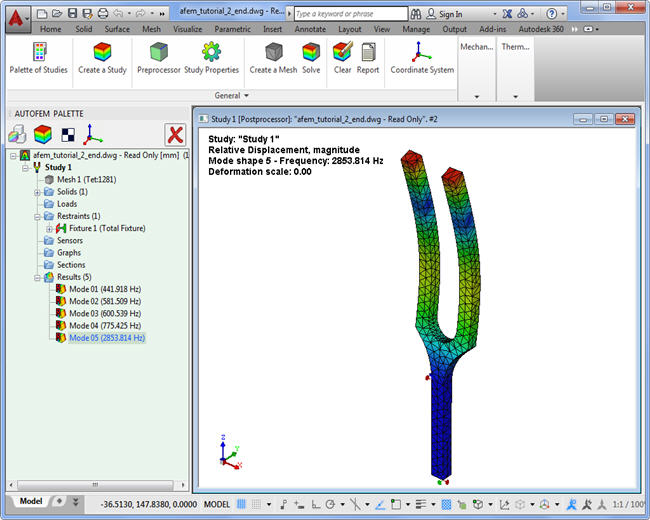
Fifth mode, Ansys WorkBench:

Fifth mode, SolidWorks Simulation:

Comparison:
|
Ansys |
CosmosWorks | ||
| First frequency, Hz |
441.92 |
440.13 |
438.84 | |
| Fifth frequency, Hz | 2,853,14 | 2,843.6 | 2,840.3 | |
| Number of tetrahedra | 1,281 | 870 |
1,105 |
Conclusion:
We can see that frequencies and shapes of modes are very close in all systems.
Buckling Analysis (critical load factor)
First buckling mode, AutoFEM Analysis:
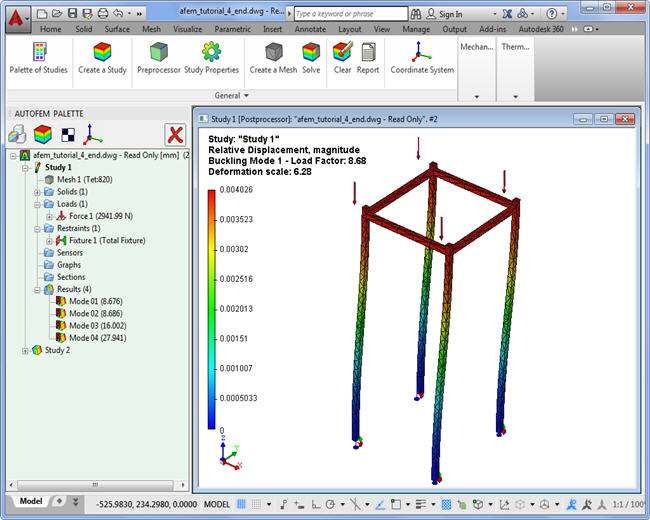
First buckling mode, Ansys WorkBench:
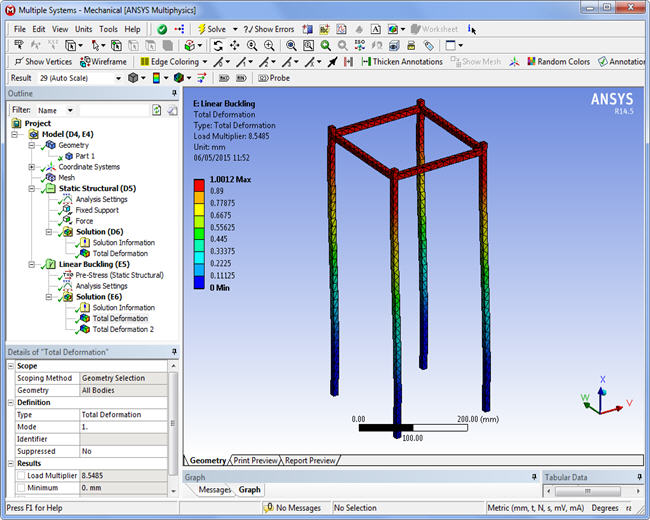
First buckling mode, SolidWorks Simulation:
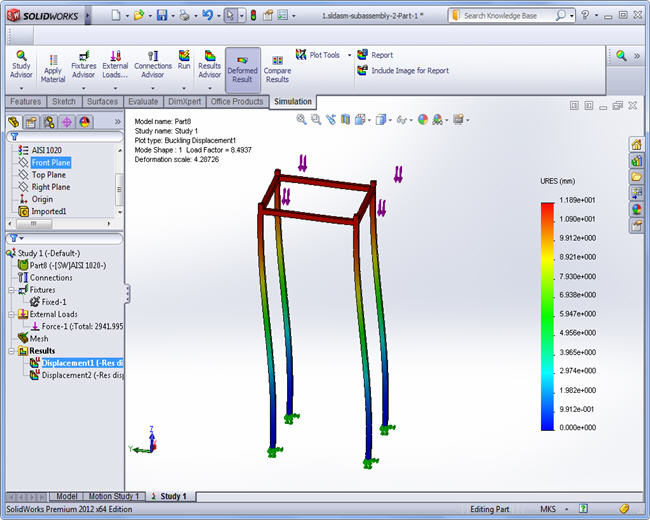
Third buckling mode, AutoFEM Analysis:

Third buckling mode, Ansys WorkBench:

Third buckling mode, SolidWorks Simulation:
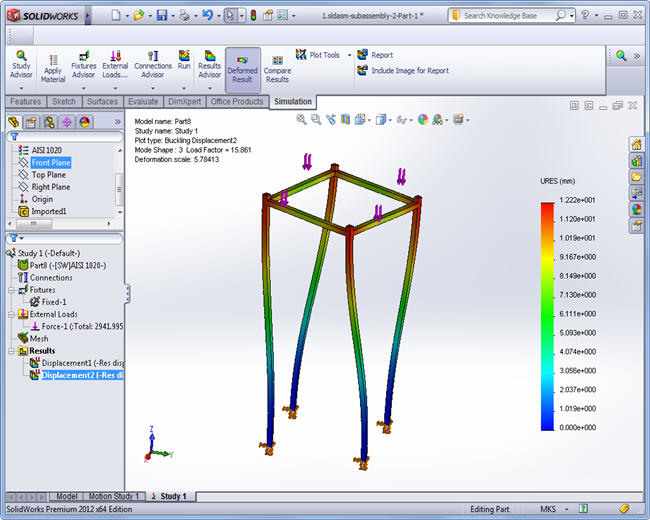
Comparison:
|
Ansys |
CosmosWorks | ||
| First Load Factor |
8.676 |
8.5485 |
8.4937 | |
| Third Load Factor | 16.002 | 15.931 | 15.861 | |
| Number of tetrahedra | 3,209 | 2.871 |
3,103 |
Conclusion:
We can see that all critical-load factors and buckling shapes are very close in all systems.
Thermal Analysis
Temperature field, AutoFEM Analysis:
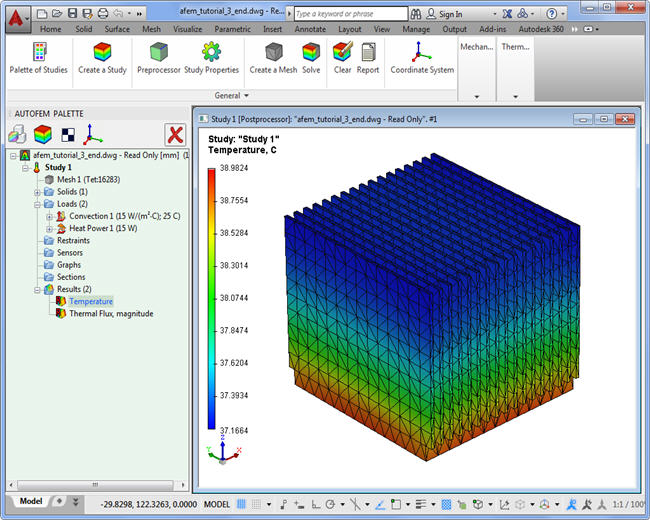
Temperature field, Ansys WorkBench:
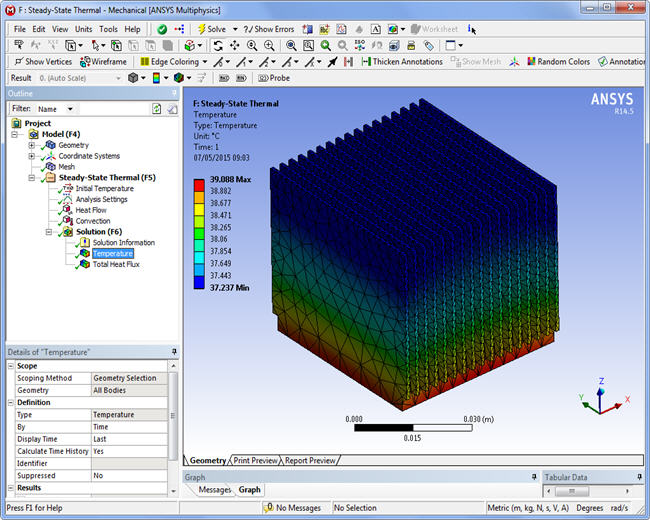
Temperature field, SolidWorks Simulation:

Thermal Flux, AutoFEM Analysis:
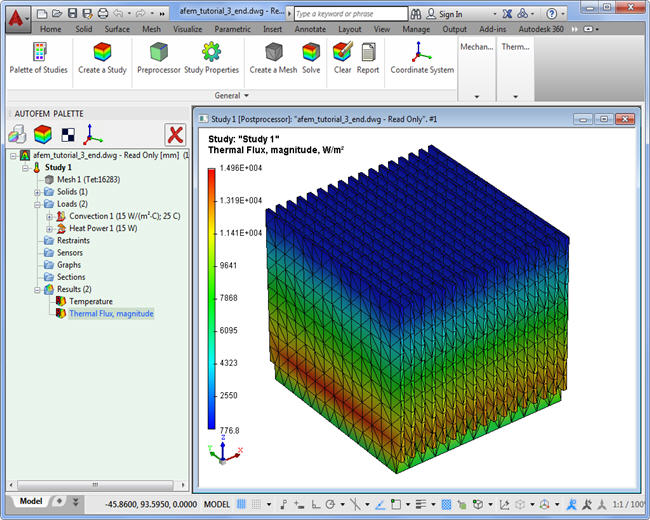
Thermal Flux, Ansys WorkBench:
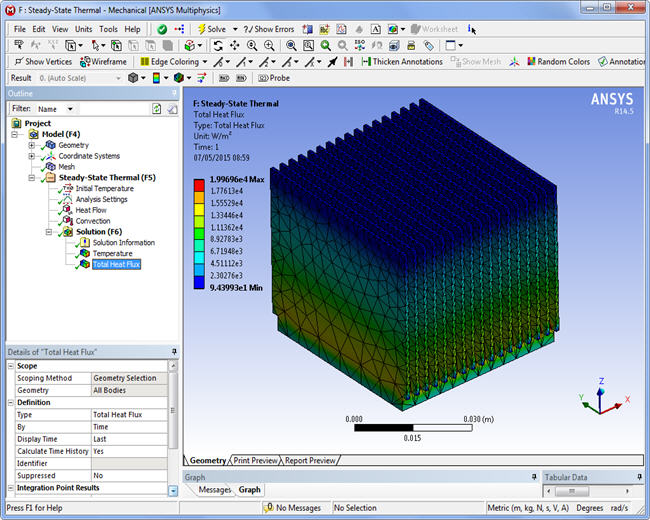
Thermal Flux, SolidWorks Simulation
:
Comparison:
|
Ansys |
CosmosWorks | ||
| Maximum Temperature, C |
38.9824 |
39.088 |
38.996 | |
| Maximum Heat Flux, W/m2 |
14,960 | 19,969 | 15,770 | |
| Number of tetrahedra | 8,710 | 20.776 |
3,103 |
Conclusion: Temperatures and thermal (heat) fluxes are close in all systems.
AutoFEM Analysis Help
- Introduction
- Lite Limitations
- Fundamentals
- Quick Start
- Preparing Finite Element Model for Analysis
- Types of Finite-Element Model
- Requirements for 3D Model
- Study: Creating, Copying, Diagnostics
- Mesh
- Material
- Graph Editor
- Defining Boundary Conditions
- Study Types
- Processing Results (Postprocessing)
- Measuring 3D Model
- Joint work with ShipConstructor software
- AutoFEM Commands
- Customization and Utility Commands
- AutoFEM Verification Tests
- AutoFEM Tutorials
- Technical Support
- Copyright
2018 AutoFEM Software LLP. All Rights Reserved.
AutoFEM Community
Small and medium companies and educational institutions as well - all select AutoFEM Analysis for finite element modelling.
Most of our users mark the following benefits:
- easiness of use and learning;
- very attractive prices for perpetual licence;
- integration with AutoCAD and ShipConstructor software.


















Testimonials
Borys Sukhanyuk, structural and calculations engineer of Skipskompetance
"I like your program very much. Interface is very nice, logic and very easy to understand and use. All operations are intuitive and easy to perform. Extremly short training time.
I am using AutoFem mostly for check of ShipConstructor structures as well as analysis of solid models where capabilities of beam analysis programs are insufficient.
Analysis can be set up quick and easy."
Volker Junicke, Logistikberatung Dipl.-Ing. (FH)
"Ich bin sehr zufrieden mit der Software. Man muss sich aber Zeit dafür nehmen, um ein gutes Ergebnis zu erzielen und oft viele Experimente durchführen, bis man ein brauchbares Netz erstellt hat."
"I am very satisfied with the software. Though, one must take time to achieve a good result and often perform many experiments until you have created a usable network."
AutoFEM Analysis Processor
The AutoFEM Analysis Processor is the main engine and brain of the system. Its function is the generation and solving systems of algebraic equations which are derived from the finite element discretization. The AutoFEM Analysis Processor has all necessary possibilities for solving linear and non linear equation systems. It uses as direct methods as well iterative methods. When necessary (in case of big systems or weak computer systems), the mode of using the disk storage turns on.
Window of settings for the static analysis solver.
Stages of solving equations and additional background information are displayed in a special information window, which indicates parameters of the finite element mesh (the number of nodes and elements), the method of solving the system of equations (direct or iterative), the order of iteration for non linear system solving, error messages and etc.
AutoFEM Processor window of the system messages.
Upon completion of calculations, a folder containing its results is created in the tree of the study in AutoFEM Palette window. These results are available for view and analysis by means of the AutoFEM Analysis Postprocessor.
ShipConstructor integration module
This optional module is intended to give all users of the ShipConstructor software the opportunity to feel all advantages of the integrated finite-element software solution. Using this module, ShipConstructor users can perform full cycle of engineering calculations (including strength, buckling and other analysis types) not leaving ShipConstructor software.




